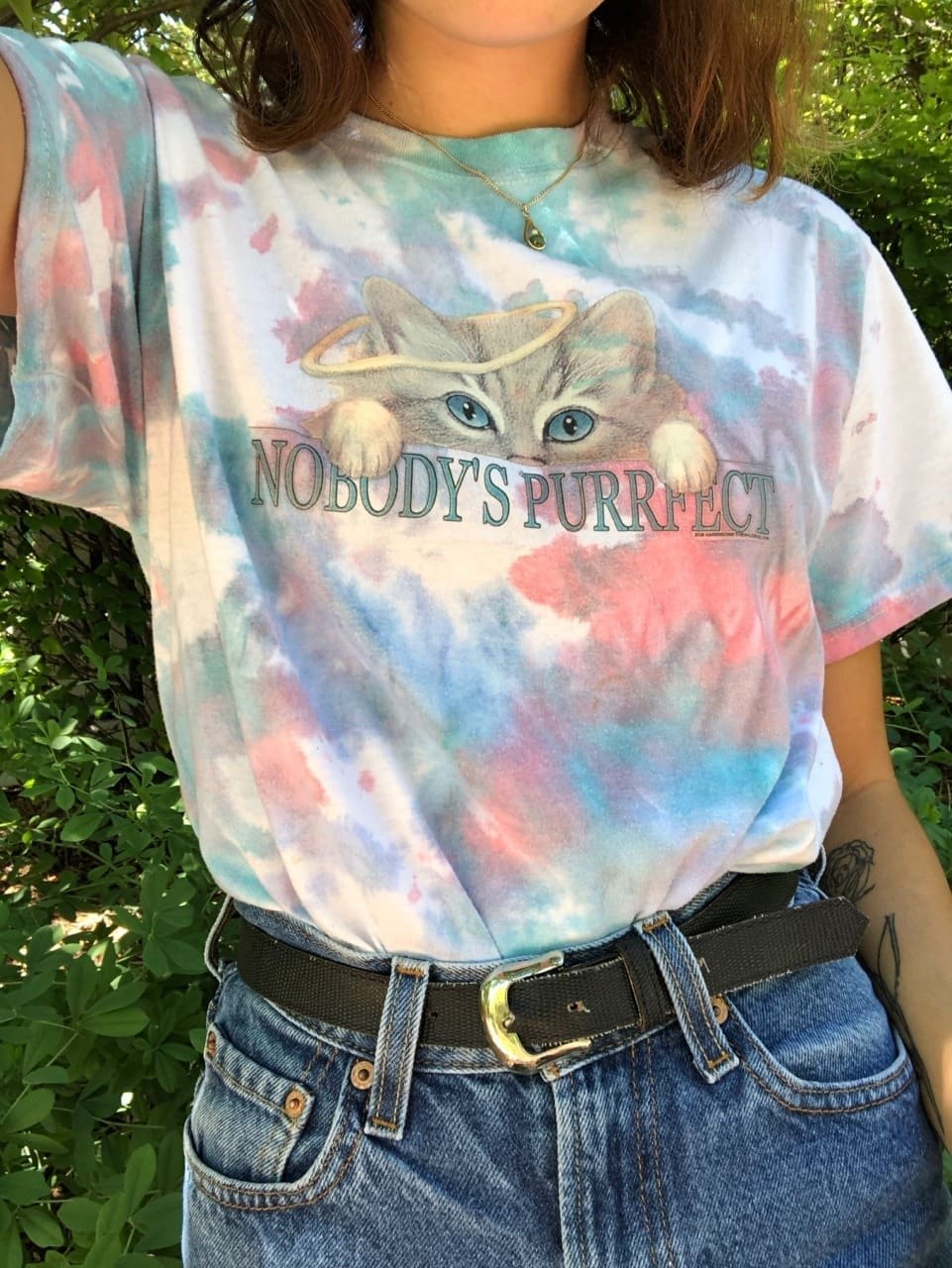In the early evenings, Esther Povitsky heads outside to begin her meditation. This being Los Angeles, you might think that involves crystals or ashwaganda, but, she says, “‘Sit down, hold your back up, close your eyes and think about nothing’—that’s not on the table for me.” The comedian, actress and podcaster prefers to keep her hands busy with her contemplative new hobby: tie-dyeing. In fact, she loves it so much, she recently started an all-tie-dyed line of “24-hour basement wear,” Sleepover by Esther, that channels what her fiancé calls her “celebrity at the airport” signature style. (Or, as she captioned one Instagram photo of her full tie-dye look: “I dress like a person who hasn’t woken up before noon since the McDonald’s breakfast menu became available all day.”)

Tie-dye has been trending in fashion circles for years at this point—from Kwaidan Editions’ cult-hit spiral T-shirt in 2017 to the fetishization of Grateful Dead shirts by streetwear-loving tastemakers from Jonah Hill to Quavo. Rihanna went viral late last year in a one-off tie-dye dress by the brand Asai, whose popularity remained at such a high that the designer recently put it into production, with 100 percent of the proceeds going to charities that support Black Lives Matter.
Still, it’s arguably reached its mass inflection point in quarantine. In the early days of the lockdown, the tie-dye sweatsuit became the official uniform for everyone from antsy celebrities stuck at home to hype-house teens. Hailey Bieber sported a rainbow set by her husband’s line Drew; Jordyn Woods wore a green version. The style equivalent of a shruggie emoji, it was casual, cheery, and youthful all at once.
As comforting as the process of making tie-dye is for Povitsky, it’s even more comforting to wear. “I’m soothed by the youthfulness” of the motif, she says. It also evokes the sunny idealism of its sixties heyday. Naomi Fry, a staff writer at The New Yorker who has written about the tie dye-centric early days of the brand Online Ceramics, thinks the phenomenon is built on “reaching back to the past as a kind of comforting thing…There’s a nostalgic element there; there’s a yearning for simplicity, for innocence. Whether it’s imagined or not is another issue.” Writer Jonah Weiner, who co-founded the fashion newsletter Blackbird Spyplane, notes that the clothing evokes “music festivals, jam-band tours, and other posi-vibed mass gatherings, all of which COVID made impossible and which we’re feeling especially nostalgic for as a result.”

Personally, I associate this particular expression of tie-dye so much with this point in time that I wondered if, to slip into programming language, it was a feature or a bug of contemporary fashion. When we look back on 2020, will it resemble, in hindsight, a sea of tie-dye in the same way that 2010 felt synonymous with digital prints? Will we still want to wear it after the ever-anticipated moment when “all this ends?”
But just when I thought I was out, tie-dye pulled me back in. A look through the resort shows led me to the conclusion that it isn’t going anywhere—it’s simply mutating. Dior, Chanel, and Gabriela Hearst were among a clutch of designers showing tie-dye for the season, but their takes felt more subdued: at Dior, it showed up on the collar of a jacket or at the hemline of a skirt, while Hearst opted for overall prints in subdued, autumnal colors.
For Fry, the print’s presence on the runway “brings it to a different realm. It’s taking something that was associated with a particular look and moving it a register.” At this point, tie-dye “almost becomes a neutral,” she says. Like khakis, jeans, or a white T-shirt, it has become “part of the American fashion vernacular that’s not wholly identified with any one label or with any one movement,” she says. “[It] can be incorporated into a person’s look in a way that doesn’t have associations that completely kill it.”
While she’s not a fan of the mass-produced iteration of the trend, Fry has a soft spot for tie-dye that feels authentic, like a homemade T-shirt she found on the street in Park Slope. “It was clearly handmade, that someone had made at camp,” she says. “When it feels more singular, or it’s less identifiable and feels a little bit more personal, I feel like that sort of thing is still quote-unquote OK to wear, and will probably continue to live on, as something relevant and not copycat-y.”
Weiner’s preferred type of tie-dye is “something that a human hand made, full of idiosyncrasies and imperfections.” Along those lines, he says, “tie-dyed clothes might speak subliminally to the isolation that people are feeling right now—not to mention the vogue for making things at home, whether it’s a shirt or a loaf of bread.” And indeed, at-home tie-dye is booming: Kacey Musgraves’s merch store now features a $99 “self-care kit” that includes a DIY tie-dye kit.
Blackbird Spyplane published a recent edition addressing the tightrope walk between coolness and lameness that is wearing tie-dye in 2020. Under-the-radar labels like Ni En More and Tezomeya were among their recommendations, and keeping the color palette subtle is crucial. “We personally have an interest in looking ‘under the radar,’ so yeah, at this point when it comes to tie-dye we’re most interested in natural- and veggie-dye techniques, where the colors are striking and subtle and age in beautiful ways, and which connect to culture-spanning, centuries-old techniques that are trend-proof,” Weiner says. “Also industrial dyes are a huge pollutant, whereas using pomegranate skins to get a shade of yellow doesn’t have the same ecological impact. And we’ve been looking at designs that deviate from the more-familiar spiral patterns, like big color-blocks or super intricate shibori where you can’t believe the piece was hand-dyed.”

